It’s likely that you’ve never seen some of the world’s most rare birds – and you’re far from alone in that. There are about 10,000 distinct bird species globally. Some are quite common, and you might spot them daily. On the other hand, some birds are so infrequent that they can go unseen for years. This post is devoted to such extraordinarily rare birds that few individuals have ever witnessed them. Starting from the giant ibis and the California condor to the Ruppell´s vulture, explore these stunningly rare birds with these 25 Rarest Birds You Might Have Never Seen.
Giant Ibis
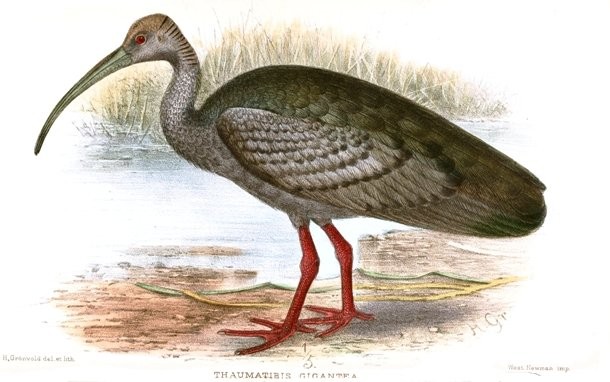 Source: wikipedia.org, image: https://commons.wikimedia.org/wiki/File:ThaumantibisGiganteaGronvold.jpg
Source: wikipedia.org, image: https://commons.wikimedia.org/wiki/File:ThaumantibisGiganteaGronvold.jpg The largest of the world´s ibises, the Giant Ibis is a large wading bird confined to northern Cambodia, with a few birds surviving in extreme southern Laos and the Yok Don National Park in Vietnam. Destruction of its natural habitat, draughts caused by climate change and overhunting drove this beautiful bird to the brink of extinction.
Forest Owlet
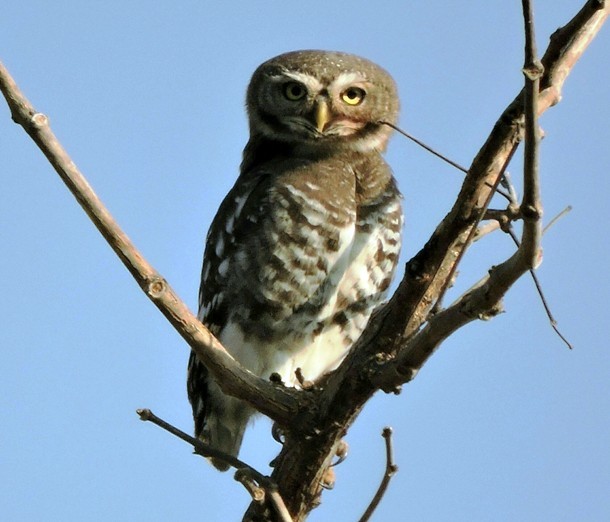 Source: wikipedia.org, image: https://commons.wikimedia.org/wiki/File:Forest_Owlet.jpg
Source: wikipedia.org, image: https://commons.wikimedia.org/wiki/File:Forest_Owlet.jpg Endemic to the forests of central India, the forest owlet is a small, stocky owl with heavily banded wings and tail. The species was already considered extinct for 113 years as there were no sightings of this bird between 1884 and 1997 when it was rediscovered. The forest owlet is only known from a small number of localities and the populations are very low within the fragmented and shrinking forests of central India, leaving the species critically endangered.
White-bellied Heron
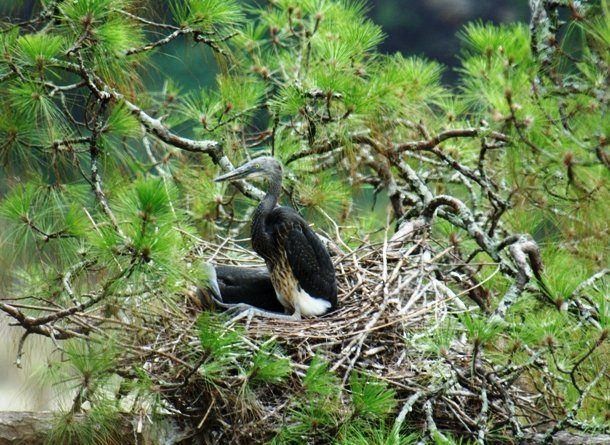 Source: wikipedia.org, image: https://commons.wikimedia.org/wiki/File:White-bellied_Heron_Ardea_insignis_nest_by_Dr._Raju_Kasambe_(2).jpg
Source: wikipedia.org, image: https://commons.wikimedia.org/wiki/File:White-bellied_Heron_Ardea_insignis_nest_by_Dr._Raju_Kasambe_(2).jpg Also known as the imperial heron, the white-bellied is a large heron found in the foothills of the eastern Himalayas in India, northeastern Bangladesh, Burma and Bhutan. Although it lives in such remote and inaccessible areas, its global population has declined dramatically and the species is seriously threatened by disturbance and habitat degradation.
Kakapo
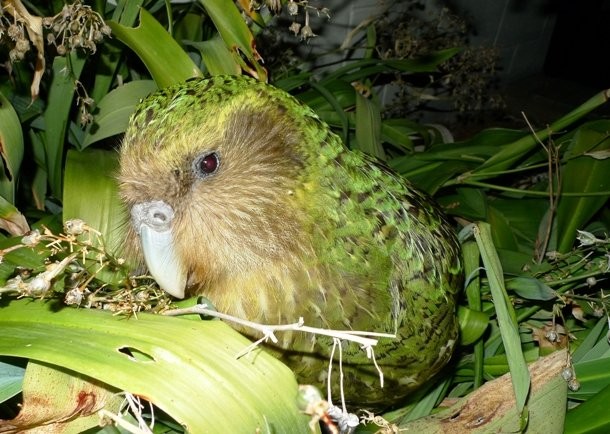 Source: wikipedia.org, image: https://en.wikipedia.org/wiki/Kakapo
Source: wikipedia.org, image: https://en.wikipedia.org/wiki/Kakapo Endemic to New Zealand, the kakapo is a species of large, flightless, nocturnal, ground-dwelling parrot. The bird was historically important to the Maori, the indigenous people of New Zealand, appearing in many of their traditional legends and folklore. As of June 2016, the total known adult population of this species was just 123 individuals, who are kept on 3 predator-free islands under the Kakapo Recovery Plan.
Sao Tome Fiscal
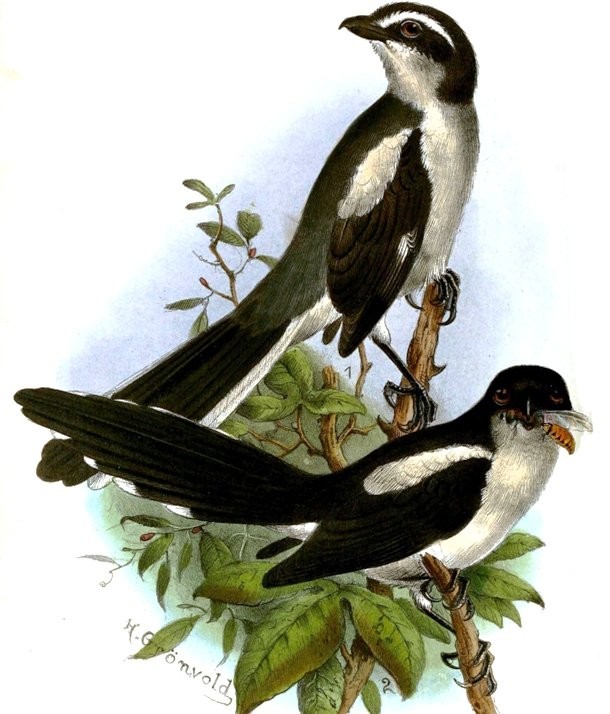 Source: wikipedia.org, image: https://commons.wikimedia.org/wiki/File:Fiscus_Gronvold.jpg
Source: wikipedia.org, image: https://commons.wikimedia.org/wiki/File:Fiscus_Gronvold.jpg Also known as the Newton’s fiscal, the Sao Tome fiscal is a small and very rare bird endemic to Sao Tome and Principe, an island country off the Western coast of Central Africa. It lives in subtropical and tropical moist lowland forests that are now cut to create coffee and cocoa plantations, leaving this nicely colored bird critically endangered.
Tooth-billed Pigeon
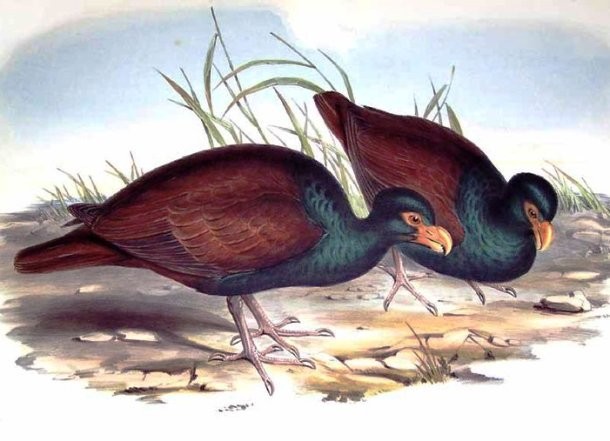 Source: wikipedia.org, image: https://commons.wikimedia.org/wiki/File:Tooth-billed_Pigeon.jpg
Source: wikipedia.org, image: https://commons.wikimedia.org/wiki/File:Tooth-billed_Pigeon.jpg Also known as the manumea, the tooth-billed pigeon is a large pigeon found only in Samoa (of which it is the national bird). Because of ongoing habitat loss, limited range, hunting and occasional cyclones as well as the impact of introduced species such as pigs, dogs, rats and cats, this bird is evaluated as critically endangered with only a few hundreds of individuals surviving in the wild.
Kagu
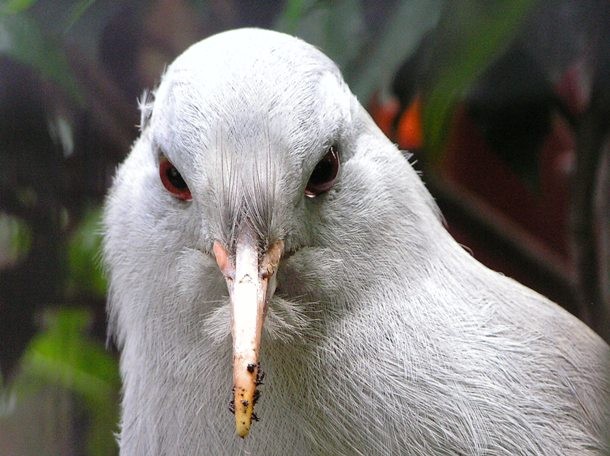 Source: wikipedia.org, image: https://commons.wikimedia.org/wiki/File:Juvenile_kagu.jpg
Source: wikipedia.org, image: https://commons.wikimedia.org/wiki/File:Juvenile_kagu.jpg The kangu is a large, up to 55 cm (22 in) long, ground-living bird endemic to the dense mountain forests of New Caledonia. Easily recognizable by its ‘nasal corns’ that are a unique feature not shared with any other bird, the kagu is exclusively carnivorous, feeding on a variety of animals such as annelid worms, snails and lizards. Unfortunately, the bird is vulnerable to introduced predators and is threatened with extinction.
California Condor
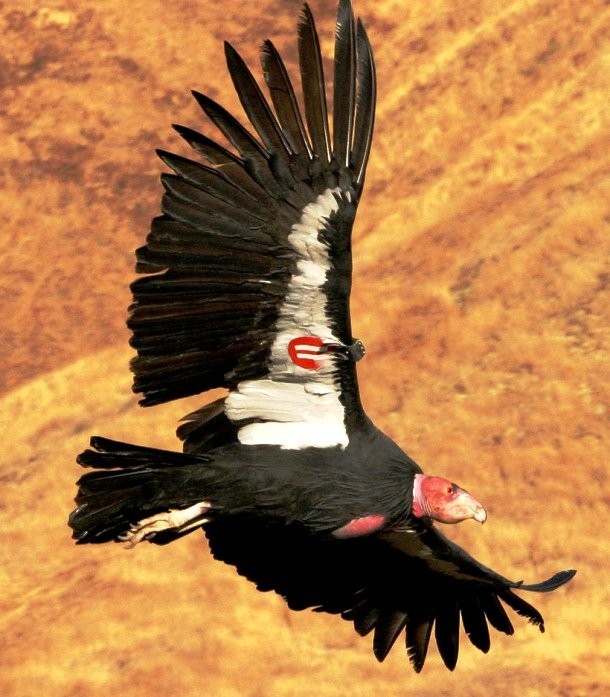 Source: wikipedia.org, image: https://www.flickr.com/photos/usfws_pacificsw/5057206247
Source: wikipedia.org, image: https://www.flickr.com/photos/usfws_pacificsw/5057206247 A New World vulture, the California condor is the largest North American land bird. It became extinct in the wild in 1987 due to poaching, lead poisoning and habitat destruction but the species has been successfully reintroduced to parts of Arizona, Utah and California. Yet, this majestic bird remains critically endangered.
Honduran Emerald
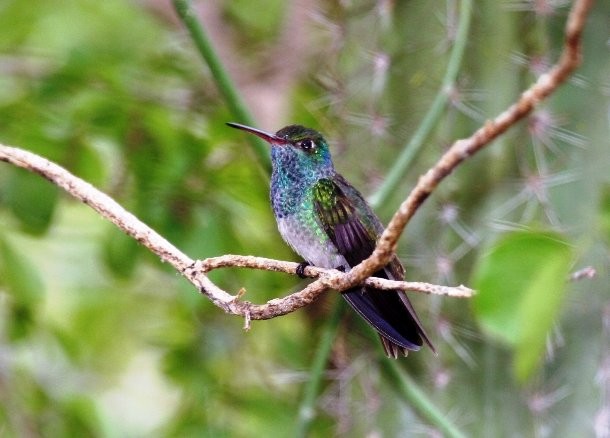 Source: wikipedia.org, image: https://commons.wikimedia.org/wiki/File:Honduran_Emerald_(Amazilia_luciae)_(2495402213).jpg
Source: wikipedia.org, image: https://commons.wikimedia.org/wiki/File:Honduran_Emerald_(Amazilia_luciae)_(2495402213).jpg Found only in Honduras, the Honduran emerald is a small species of hummingbird. Living in subtropical and tropical forests and shrub lands, the Honduran emerald is seriously threatened by habitat loss and deforestation. The only area where it is locally common is in arid thorn forest and scrub in the upper Rio Aguan Valley in central Honduras.
Ivory-billed Woodpecker
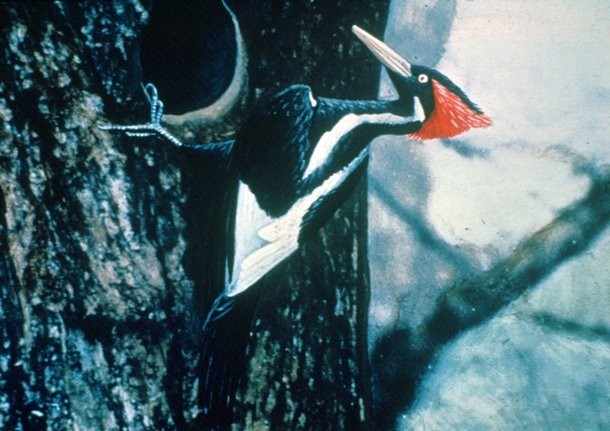 Source: wikipedia.org, image: https://commons.wikimedia.org/wiki/File:Ivory-billed_Woodpecker_by_Jerry_A._Payne.jpg
Source: wikipedia.org, image: https://commons.wikimedia.org/wiki/File:Ivory-billed_Woodpecker_by_Jerry_A._Payne.jpg Native to the virgin forests of the Southeastern United States, the ivory-billed woodpecker is one of the largest woodpeckers in the world, at roughly 50 cm (20 in) long and 76 cm (30 in) in wingspan. Massive destruction of its natural habitat caused this bird to be critically endangered. However, it might be possible that the bird is already extinct as there have been no sightings of this bird in recent years.
Christmas Frigatebird
 Source: wikipedia.org, image: https://sw.wikipedia.org/wiki/Picha:Christmas_Island_Frigatebird_male_-_Jakarta_Bay_MG_5699_(29809183265).jpg
Source: wikipedia.org, image: https://sw.wikipedia.org/wiki/Picha:Christmas_Island_Frigatebird_male_-_Jakarta_Bay_MG_5699_(29809183265).jpg Endemic to the Christmas Island in the Indian Ocean, the Christmas frigatebird is a large, lightly built seabird with brownish-black plumage, long narrow wings and a deeply forked tail. The total adult population of this beautiful bird is estimated to be around a few thousand surviving individuals.
Bird are not the only creatures suffering from possible extinction. Take a look at 25 of the rarest animals in the world by clicking on this link.
Siberian Crane
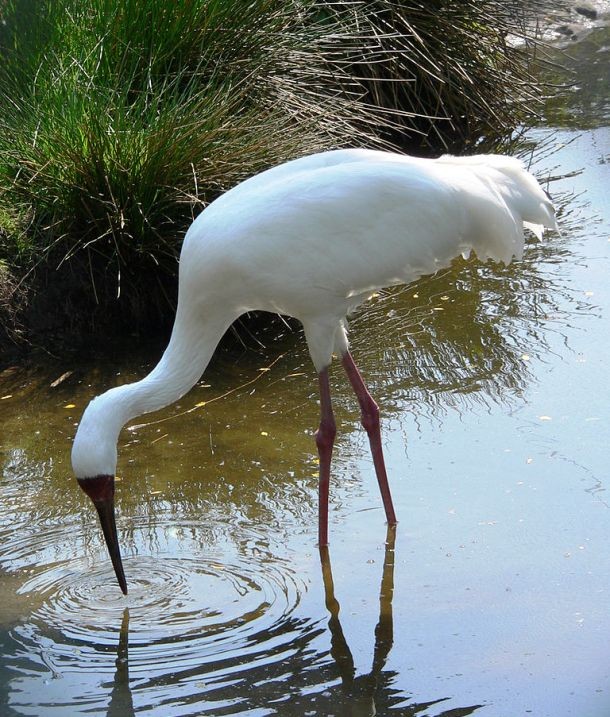 Source: wikipedia.org, image: https://commons.wikimedia.org/wiki/File:Schneekranich_Grus_leucogeranus_090501_We_147.JPG
Source: wikipedia.org, image: https://commons.wikimedia.org/wiki/File:Schneekranich_Grus_leucogeranus_090501_We_147.JPG Also known as the snow crane, the Siberian crane is a large, snowy white crane with distinctive black primary feathers that are visible in flight. With a wing span of up to 230 cm (91 in) and weight of up to 15 kg (33 lb), it is one the largest and also rarest cranes in the world. The total population of the Siberian crane is estimated to be around 3,000 to 4,000 birds most of which now live in China.
Glaucous Macaw
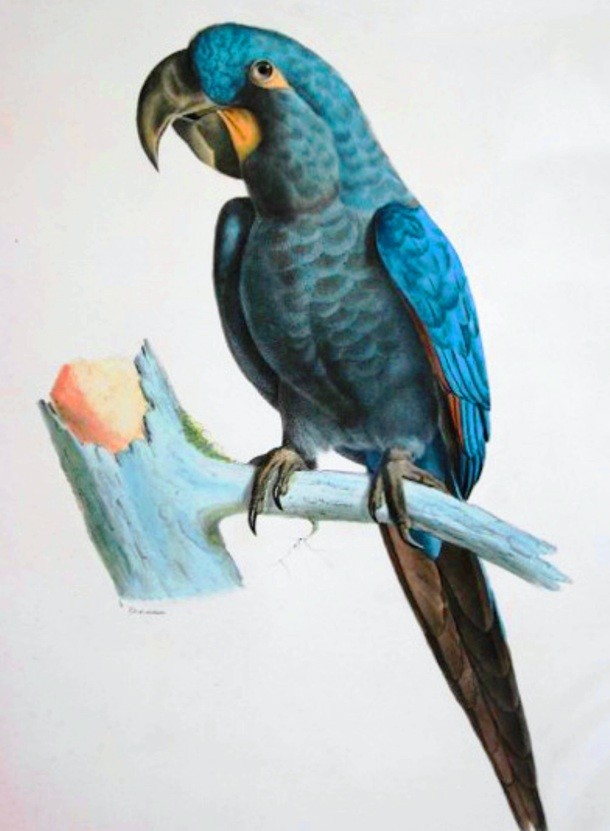 Source: wikipedia.org, image: https://commons.wikimedia.org/wiki/File:Anodorhynchus_glaucus.jpg
Source: wikipedia.org, image: https://commons.wikimedia.org/wiki/File:Anodorhynchus_glaucus.jpg The glaucous macaw is a large South American parrot, a member of a large group of neotropical parrots known as macaws. Once common in Argentina, Brazil, Paraguay, Uruguay and Bolivia, this macaw is mostly pale turquoise-blue with a large, greyish head, long tail and a powerful bill. The glaucous macaw is classified as critically endangered but it might be extinct as it has not been seen for decades.
Oahu Alauahio
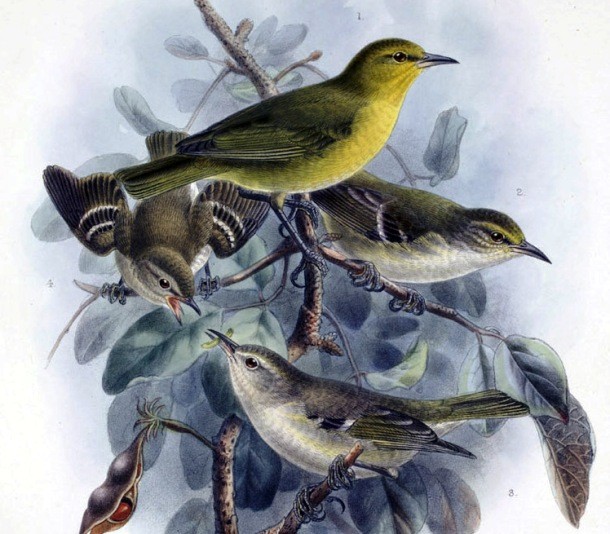 Source: wikipedia.org, image: https://commons.wikimedia.org/wiki/File:Paroreomyza_maculata.jpg
Source: wikipedia.org, image: https://commons.wikimedia.org/wiki/File:Paroreomyza_maculata.jpg Also known as the Oahu creeper, the Oahu alauahio is a small, up to 10 cm (4 in) long finch-like bird that is endemic to the Hawaiian island of Oahu. The bird is critically endangered and may be extinct because of disease (avian malaria), invasive plants and wildlife; and habitat loss. The last confirmed record occurred in 1985.
Great Indian Bustard
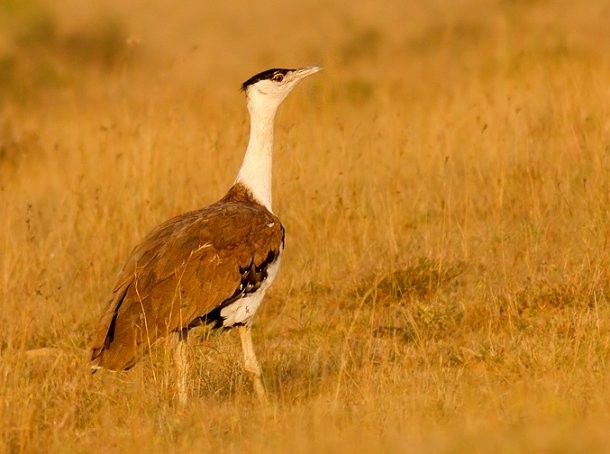 Source: wikipedia.org, image: https://commons.wikimedia.org/wiki/File:Great_Indian_bustard.jpg
Source: wikipedia.org, image: https://commons.wikimedia.org/wiki/File:Great_Indian_bustard.jpg The Great Indian Bustard is a bustard found in India and the adjoining regions of Pakistan. A large bird with a horizontal body and long bare legs, giving it an ostrich like appearance, it is one of the heaviest flying birds. Once common on the dry plains of the Indian subcontinent, as few as 250 individuals were estimated in 2011 to survive as this bird´s population is drastically decimated by hunting and habitat loss.
Nihoa Millerbird
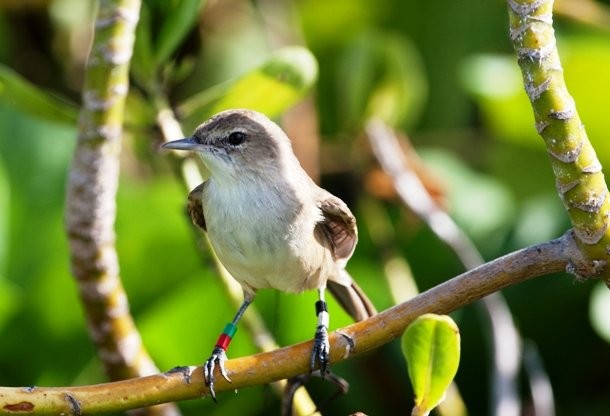 Source: wikipedia.org, image: https://commons.wikimedia.org/wiki/File:Acrocephalus_familiaris_-Laysan,_Northwestern_Hawaiian_Islands,_USA-8.jpg
Source: wikipedia.org, image: https://commons.wikimedia.org/wiki/File:Acrocephalus_familiaris_-Laysan,_Northwestern_Hawaiian_Islands,_USA-8.jpg Confined to the tiny island of Nihoa in the Northwestern Hawaiian Islands, the Nihoa Millerbird is a small millerbird with dark, sepia-colored feathers, white belly, and dark beak. Only a few hundreds of these birds are estimated to persist on the island, making the species seriously endangered. It is always at risk of extinction from environmental changes (droughts, fires, insect population irruptions), because flight away from the island would likely prove fatal.
Madagascan Pochard
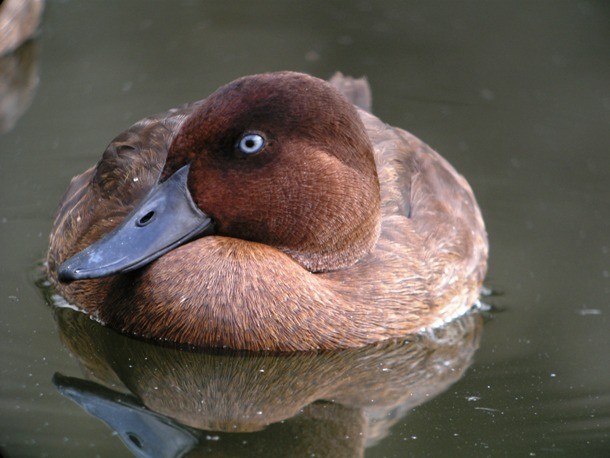 Source: wikipedia.org, image: https://commons.wikimedia.org/wiki/File:Madagascar_Pochard,_Captive_Breeding_Program,_Madagascar.jpg
Source: wikipedia.org, image: https://commons.wikimedia.org/wiki/File:Madagascar_Pochard,_Captive_Breeding_Program,_Madagascar.jpg The Madagascan pochard is an extremely rare diving duck of the genus Aythya. Thought to be extinct in the late 1990s’ (due to introduction of new predators, hunting and habitat loss), specimens of the species were rediscovered at the Lake Matsaborimena in Madagascar in 2006. As of March 2013, the population was estimated to be around 80 individuals.
Ruppell's Vulture
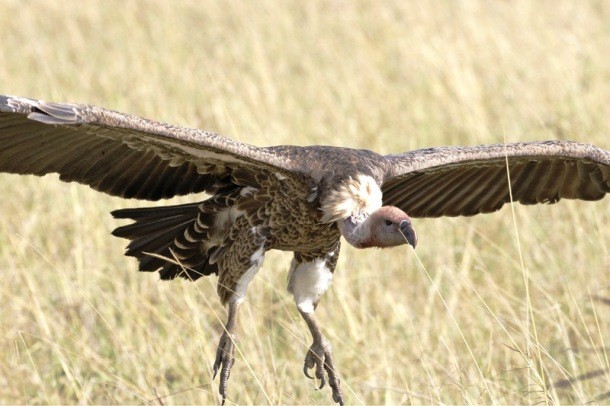 Source: wikipedia.org, image: https://commons.wikimedia.org/wiki/File:Ruppell's_griffon_vulture_-_Rueppell's_Griffon_(Gyps_rueppellii)_-_Flickr_-_Lip_Kee.jpg
Source: wikipedia.org, image: https://commons.wikimedia.org/wiki/File:Ruppell's_griffon_vulture_-_Rueppell's_Griffon_(Gyps_rueppellii)_-_Flickr_-_Lip_Kee.jpg The Ruppell’s vulture is a large vulture that occurs throughout the Sahel region of central Africa. The current population of 30,000 is decreasing due to loss of habitat, deliberate poisoning by ivory poachers and other factors. With a wingspan of up to 2.6 m (8.5 ft), this vulture is considered to be the highest-flying bird, with confirmed evidence of flight at an incredible altitude of 11,300 m (37,100 ft) above sea level.
Horned Curassow
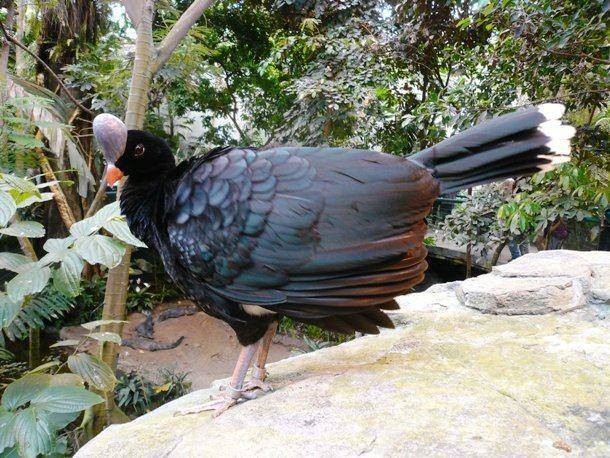 Source: wikipedia.org, image: https://commons.wikimedia.org/wiki/File:Northern_Helmeted_Curassow.jpg
Source: wikipedia.org, image: https://commons.wikimedia.org/wiki/File:Northern_Helmeted_Curassow.jpg Also known as the southern helmeted curassow, the horned curassow is a species of bird in the Cracidae family found in humid tropical and subtropical forests of Bolivia. This large, predominantly black bird with a big, distinctive casque on its forehead, has become very rare as it has been suffering from habitat loss and human disturbance.
Swift Parrot
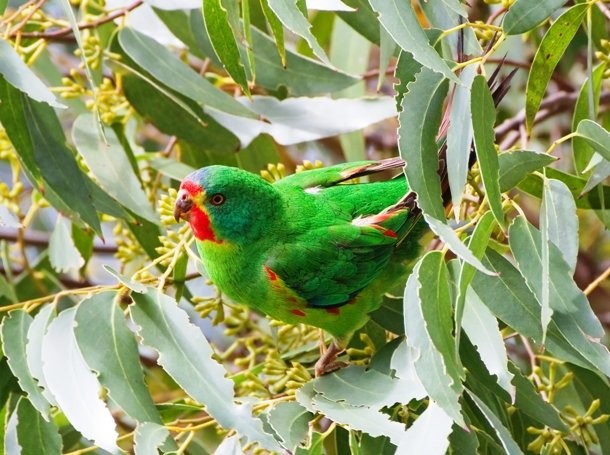 Source: wikipedia.org, image: https://commons.wikimedia.org/wiki/File:Lathamus_discolor_Bruny_1.jpg
Source: wikipedia.org, image: https://commons.wikimedia.org/wiki/File:Lathamus_discolor_Bruny_1.jpg The swift parrot is about 25 cm (10 in) long with long pointed wings and long tapering tail feathers. It is mainly green with bluish crown and red on the face above and below the beak. The swift parrot migrates across the Bass Strait between Tasmania and the mainland of Australia. Decimated by habitat loss and predation, this bird´s population was estimated to be fewer than 2,000 individuals in the wild in 2011.
Madagascan Fish Eagle
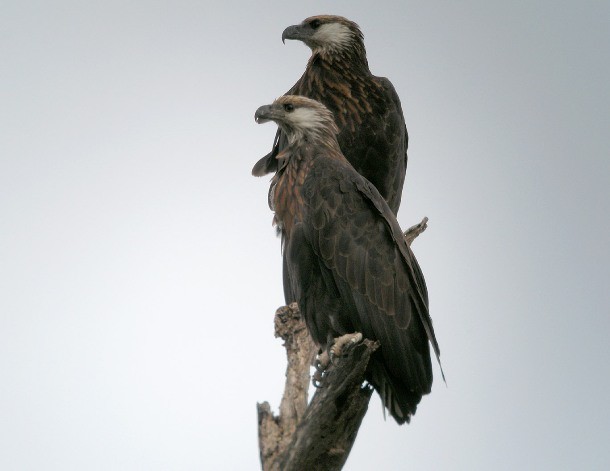 Source: wikipedia.org, image: https://commons.wikimedia.org/wiki/File:Madagascar_Fish_Eagle,_Lake_Ravelobe,_Ankarafantsika_National_Park,_Madagascar.jpg
Source: wikipedia.org, image: https://commons.wikimedia.org/wiki/File:Madagascar_Fish_Eagle,_Lake_Ravelobe,_Ankarafantsika_National_Park,_Madagascar.jpg Endemic to the coastal strip in the northwest of Madagascar, the Madagascan fish eagle is a large bird of prey with brown head and body, and a white tail. It has been suffering from a declining population and is seriously threatened by habitat destruction and persecution. With only about 40 surviving breeding pairs, the Madagascan fish eagle is one of the rarest birds on Earth.
Walden's Hornbill
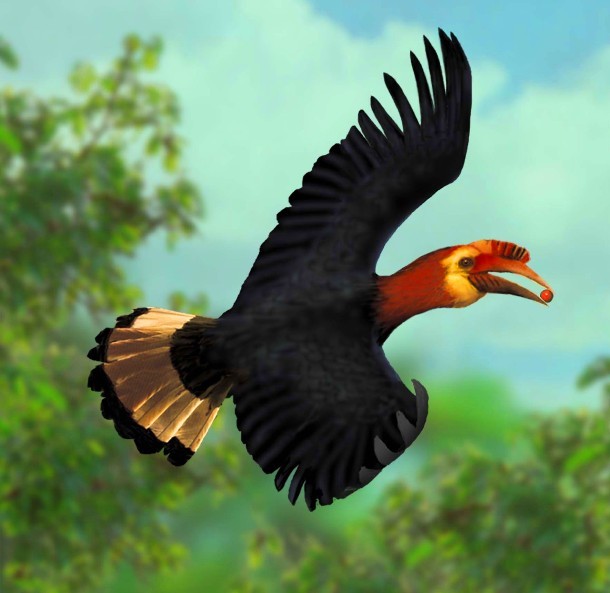 Source: wikipedia.org, image: https://commons.wikimedia.org/wiki/File:A_waldeni_flying.jpg
Source: wikipedia.org, image: https://commons.wikimedia.org/wiki/File:A_waldeni_flying.jpg Locally called dulungan, the Walden’s hornbill is a critically endangered species of hornbill living in the rainforests on the islands of Negros and Panay in the Philippines. They reproduce very slowly and thus are unable to survive high hunting pressures coupled with heavy logging of the rainforests. There might be just a few last hundreds of these beautifully colored birds surviving in the wild.
Brazilian Merganser
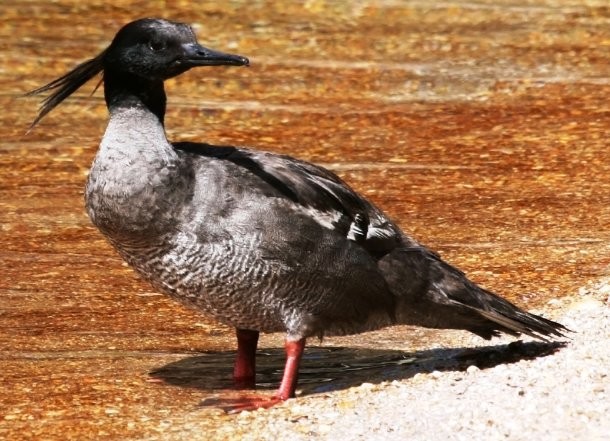 Source: wikipedia.org, image: https://commons.wikimedia.org/wiki/File:Mergus_octosetaceus_2.png
Source: wikipedia.org, image: https://commons.wikimedia.org/wiki/File:Mergus_octosetaceus_2.png The Brazilian merganser is a duck in the typical merganser genus. It is one of the six most threatened waterfowl in the world with possibly fewer than 250 birds in the wild and currently 4 kept in captivity at 2 different Brazilian locations. The origin of its name is from its long, sharp-edged beak that has a great number of teeth-looking edges.
Spoon-billed Sandpiper
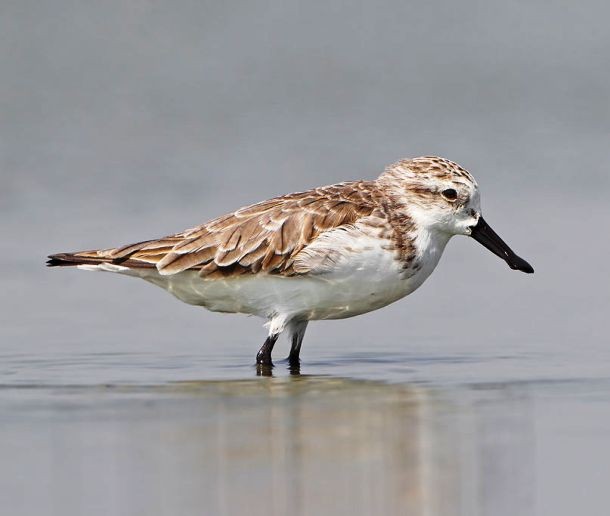 Source: wikipedia.org, image: https://commons.wikimedia.org/wiki/File:Eurynorhynchus_pygmeus_2_-_Pak_Thale.jpg
Source: wikipedia.org, image: https://commons.wikimedia.org/wiki/File:Eurynorhynchus_pygmeus_2_-_Pak_Thale.jpg The spoon-billed sandpiper is a small wader recognizable by its distinctive spatula-like bill. A migratory bird, it breeds in north-eastern Russia and then travels about 8,000 km (5,000 mi) to spend winter in Southeast Asia. The main threats to its survival are habitat loss on its breeding grounds and loss of tidal flats through its migratory and wintering range.
Junin Grebe
 Source: wikipedia.org, image: https://commons.wikimedia.org/wiki/File:Junin-Grebe-Podiceps-tacznowskii_Photo_-_Gunnar_Engblom,_Kolibri_Expeditions.jpg
Source: wikipedia.org, image: https://commons.wikimedia.org/wiki/File:Junin-Grebe-Podiceps-tacznowskii_Photo_-_Gunnar_Engblom,_Kolibri_Expeditions.jpg Also known as puna grebe, the Junin grebe is a medium-size grebe found only on the Lake Junin in the highlands of west-central Peru. There were several attempts to translocate this bird to other lakes in the area but these efforts were not successful. Currently, there’s only about 250 individuals left in the wild.



























